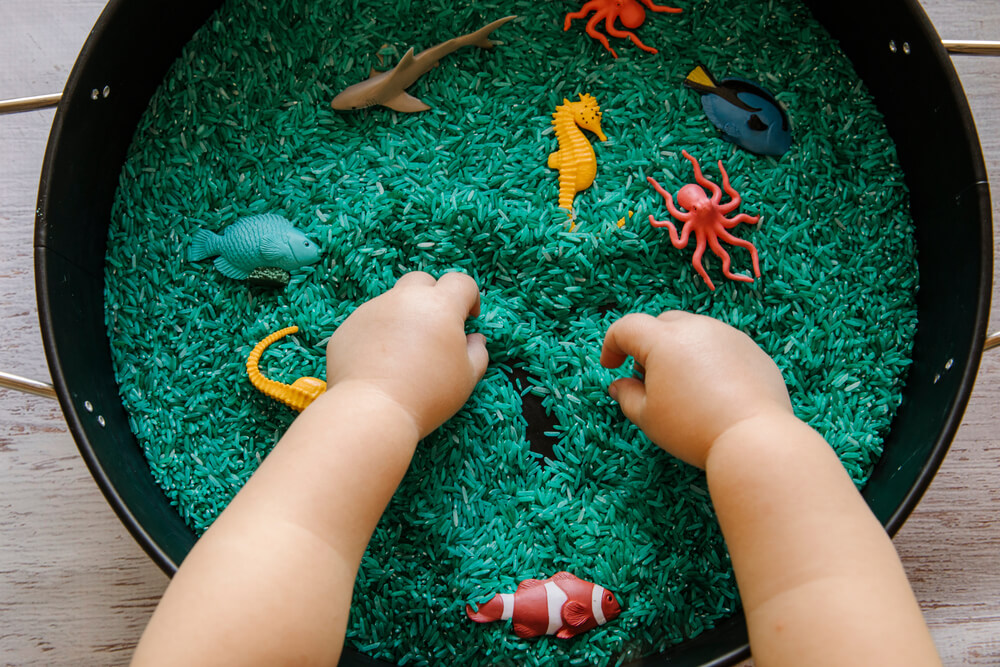As a parent of an autistic child, you may have noticed that your child may struggle with processing and understanding sensory information. This can lead to difficulties in everyday tasks and challenges in social interactions. However, sensory play can be a great way to help your child regulate and integrate their senses, improving their overall sensory processing skills.
My World ABA offers sensory play ideas and techniques have been proven helpful for autistic children. From calming activities to stimulating games, these ideas can be incorporated into your child’s daily routine to promote their development and well-being.
Related Post: Maximizing Your Child’s Comfort: The Importance of a Sensory Backpack for Autism
Understanding Sensory Play and Its Importance for Autistic Children
Sensory play involves activities that engage one or more of the five senses—sight, sound, touch, taste, and smell—alongside the two less frequently mentioned senses: proprioception (sense of body position) and vestibular sense (sense of balance). For autistic children, who often experience sensory processing differences, these activities can be vital.
Sensory play helps in enhancing neural connections through repeated sensory interactions, fostering cognitive growth, fine and gross motor skills development, and improving social interactions. This form of play is especially beneficial as it can be tailored to each child’s unique sensory needs and preferences, whether they seek extra stimulation or require help tolerating various sensory inputs.
Tactile Sensory Activities to Soothe and Stimulate
Tactile sensory activities are a cornerstone of effective sensory play, offering autistic children the chance to explore textures and sensations safely and enjoyably.
- One simplest yet most engaging tactile activity involves creating a sensory bin. Fill a large container with dry rice, beans, or sand, and embed various toys or objects for your child to discover.
- For a soothing experience, consider a tactile board or book made from different textures, such as felt, fur, silk, and sandpaper. The variety provides a calming exploration of touch, helping children who may be sensitive to certain textures to acclimate gently at their own pace.
- Playdough, slime, or kinetic sand also offer excellent opportunities for tactile play, allowing children to mold, stretch, and press materials, stimulating their touch sense and aiding in stress relief and focus.
Incorporating these tactile sensory activities into your child’s routine can significantly enhance their sensory processing and create a joyful learning experience tailored to their needs and preferences.
Visual Sensory Activities to Engage and Calm
Visual sensory activities are crucial in stimulating and calming the visual processing system of autistic children.
- A popular and practical activity is using light tables or boxes, which provide a softly illuminated surface for children to explore colored translucent shapes, letters, and numbers, enhancing visual tracking and color recognition skills.
- Creating a homemade lava lamp with water, oil, and food coloring can captivate a child’s attention, offering a mesmerizing visual experience that can calm and soothe.
- For those who prefer less direct light, shadow play can be an excellent alternative, using hands or toys to create stories on a wall or ceiling with the help of a flashlight or lamp.
- Incorporating visual sensory activities that involve glowing or moving objects, such as spinning tops or light-up toys, can also provide engaging visual stimuli that foster focus and visual tracking abilities.
These activities enrich a child’s sensory diet and create opportunities for them to engage with their environment in a comforting and stimulating way, catering to their individual sensory preferences.
Auditory Sensory Activities for Soothing Sound Experiences
Auditory sensory activities are an essential aspect of sensory play, catering specifically to the needs of children who might find certain sounds overwhelming or, conversely, find particular auditory input soothing.
- One effective method is using sound therapy through calming music or natural sounds, such as waves crashing or rain falling. These sounds can have a profound calming effect, helping to reduce anxiety and promote relaxation.
- Engaging in interactive activities like making homemade musical instruments can provide a fun and controlled way to explore sounds. Instruments can be as simple as rice-filled containers used as shakers or rubber bands stretched over a box to create a makeshift guitar.
- For a more tactile and auditory combined experience, sensory bottles filled with items that create soothing sounds when shaken, such as beads or small bells, can be particularly enchanting.
Offering a variety of auditory sensory activities allows children to explore sounds safely and enjoyably, catering to their unique sensory processing needs.
Incorporating Movement for Proprioceptive and Vestibular Input
Incorporating movement into sensory play can significantly benefit autistic children by engaging their proprioceptive and vestibular systems, crucial for understanding body position, movement, and balance.
- Activities like swinging, bouncing on a therapy ball, or jumping on a trampoline can provide the necessary vestibular input that helps regulate a child’s sense of balance and spatial orientation.
- Activities that involve pushing, pulling, or lifting objects can enhance proprioceptive input, giving the child a better understanding of their body in relation to the space around them.
- Simple yet effective games like “Simon Says” can also be tailored to involve various movements that stimulate these senses.
- Obstacle courses created with cushions, tunnels, and balance beams encourage children to navigate different physical challenges, promoting proprioceptive and vestibular development.
These movement-based activities aid in sensory integration, support motor skills development, and can significantly improve a child’s coordination and confidence in their physical abilities.
Related Post: Empowering Autistic Children: Tips for Building Their Independence
Creating a Sensory Safe Space at Home
Creating a sensory safe space at home involves dedicating a specific area where your autistic child can feel secure, calm, and supported in managing sensory input. This personalized space should be tailored to suit their sensory preferences and needs, whether they require a quiet retreat from overwhelming stimuli or a designated area for engaging in sensory play.
- Start by choosing a room or corner that can be easily adjusted to minimize sensory overload—this may mean dimmable lights for sensitive eyes, noise-canceling headphones available for sensitive ears, or soft rugs and pillows for those who seek tactile comfort.
- Incorporate elements from previous sensory activities, such as tactile bins or visual aids like a lava lamp, to enhance the environment.
- The key is to make this space adaptable, allowing for changes based on your child’s evolving needs and preferences.
Remember, this haven is about reducing negative sensory experiences and empowering your child to explore their senses in a comforting, controlled setting.
ABA Therapy in Springfield and Joplin
My World ABA provides ABA therapy in Joplin and Springfield, MO. Our approach is based on kindness and understanding, and we strive to create a fun and inclusive environment where your child will feel welcome.
To learn more about our services or answer additional questions, visit our website or call (417) 818-5784 today.





